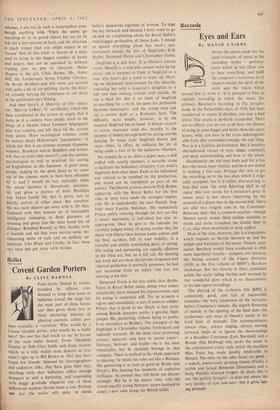Records
Eyes and Ears
By DAVID CAIRNS AFTER the claims made for the latest triumphs of opera in the recording studio — perform- ances which at last allow you to hear everything, and fulfil the composer's intentions in all respects except the spirit of the work and the vision which moved him to write it—it is pleasant to find an operatic recording in which the music has primacy. Beecham's recording of The Seraglio, made in the Palaeolithic days of 1956, has been transferred to stereo (Columbia, two and a half discs). The sound is perfectly acceptable. There are no effects, you do not at all have the illusion of being in some bigger and better-than-life opera house; what you hear is far from indistinguish- able from that outmoded concept, the real thing. Nor is it a faultless performance. But it breathes old-fashioned virtues of style, shape, continuity and deep understanding and love of the music.
Occasionally the old man nods and for a few bars the music loses vitality; and he is not averse to making a few cuts. Perhaps this was to get the recording on to the two discs which it origi- nally occupied; but it is rather disconcerting to find that even 'the most haunting idyll in all opera' (his own words for Constanze's great G minor aria) is not above improving by the removal of a dozen bars in the second half. There are also two longish cuts in the Constanze- Belmonte duet; this is common practice—though Mozart surely meant these endless ecstasies in thirds and sixths (compare the similar duet in Cosi, also often shortened) to seem endless.
Most of the time, however, this is a conception which imposes no barrier between us and the delight and freshness of the music. Twenty years earlier Beecham would have conducted it with more superficial vivacity: compare, for instance, the fizzing account of the Figaro Overture (1939) in the first volume of HMV's Beecham Anthology. But the vivacity is there, contained within the easily riding rhythm and warmed by that wonderful glow which is so characteristic of his late opera recordings.
The playing of the orchestra (the RPO) is consistently good, and full of memorable moments—the holy tenderness of the recitative before Constanze's lament, the superb flowering of melody at the, opening of the final duet, the exuberance and snap of Osmin's music in his brief hour of triumph. The accompaniment, always clear, always singing, always moving forward, helps us to ignore the shortcomings of a bloodless Constanze (Lois Marshall) and a Blonde (Ilse Hollweg) who pecks the music in the conventional aviary style which the excellent Miss Freni has made doubly intolerable in Mozart. The men; on the other hand, are good-- a superb, monstrously gloating Osmin (Frick), a stylish and lyrical Belmonte (Simoneau) and a lively Pedrillo (Gerard Unger). In short, this is not 'the perfect Seraglio'—it does not amaze the very faculty of eyes and ears—but it gives last- ing pleasure.


































 Previous page
Previous page